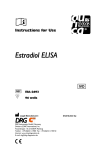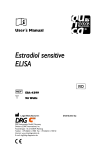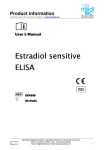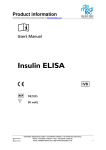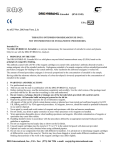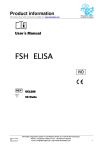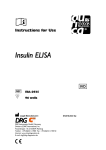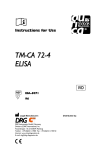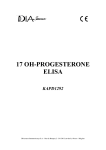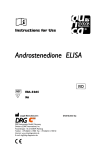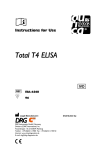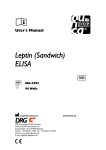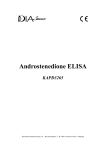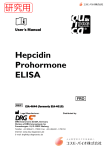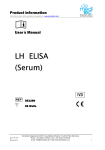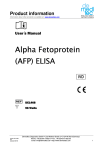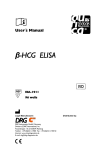Download DE2693 Estradiol ELISA 141014 m
Transcript
Product information Information about other products is available at: www.demeditec.com Userś Manual Estradiol ELISA DE2693 96 wells Version 12-09/14 JS Updated 141014 Demeditec Diagnostics GmbH • Lise-Meitner-Straße 2 • D-24145 Kiel (Germany) Phone: +49 (0)431/71922-0 • Fax. +49 (0)431/71922-55 Email: [email protected] • http://www.demeditec.com 1 Demeditec Estradiol ELISA DE2693 Contents / Inhaltsverzeichnis / Contenuti / Contenido / Contenu 1 2 3 4 5 6 7 8 9 10 11 12 INTRODUCTION .............................................................................................................................................. 3 PRINCIPLE OF THE TEST .............................................................................................................................. 3 WARNINGS AND PRECAUTIONS................................................................................................................... 4 REAGENTS ...................................................................................................................................................... 5 SPECIMEN COLLECTION AND PREPARATION ............................................................................................ 5 ASSAY PROCEDURE ...................................................................................................................................... 6 EXPECTED NORMAL VALUES ...................................................................................................................... 7 QUALITY CONTROL ........................................................................................................................................ 8 PERFORMANCE CHARACTERISTICS ........................................................................................................... 8 LIMITATIONS OF USE ..................................................................................................................................... 9 LEGAL ASPECTS .......................................................................................................................................... 10 REFERENCES / LITERATURE ...................................................................................................................... 11 1 2 3 4 5 6 7 8 9 10 11 12 EINLEITUNG .................................................................................................................................................. 12 TESTPRINZIP ................................................................................................................................................ 12 VORSICHTSMAßNAHMEN ............................................................................................................................ 12 BESTANDTEILE DES KITS ........................................................................................................................... 13 PROBENVORBEREITUNG ............................................................................................................................ 14 TESTDURCHFÜHRUNG ................................................................................................................................ 14 ERWARTETE WERTE ................................................................................................................................... 16 QUALITÄTS-KONTROLLE ............................................................................................................................. 16 ASSAY CHARACTERISTIKA ......................................................................................................................... 16 GRENZEN DES TESTS ................................................................................................................................. 17 RECHTLICHE GRUNDLAGEN....................................................................................................................... 17 REFERENZEN / LITERATUR ........................................................................................................................ 17 1 2 3 4 5 6 7 8 9 10 11 12 INTRODUZIONE ............................................................................................................................................ 18 PRINCIPIO DEL TEST ................................................................................................................................... 18 PRECAUZIONI ............................................................................................................................................... 18 COMPONENTI DEL KIT ................................................................................................................................. 19 CAMPIONI ...................................................................................................................................................... 20 ATTUAZIONE DEL TEST ............................................................................................................................... 20 VALORI NORMALI ......................................................................................................................................... 22 CONTROLLO QUALITÀ ................................................................................................................................. 22 CARATTERISTICHE DEL TEST .................................................................................................................... 22 LIMITAZIONE DEL TEST ............................................................................................................................... 23 ASPETTI LEGALI ........................................................................................................................................... 23 BIBLIOGRAFIA ............................................................................................................................................... 23 1 2 3 4 5 6 7 8 9 10 11 12 INTRODUCTION ............................................................................................................................................ 24 PRINCIPE DU TEST ...................................................................................................................................... 24 PRECAUTIONS D’UTILISATION ................................................................................................................... 24 COMPOSITION DU KIT ................................................................................................................................. 25 ECHANTILLON............................................................................................................................................... 26 RÉALISATION DU TEST................................................................................................................................ 26 VALEURS ATTENDUES ................................................................................................................................ 28 CONTROLE DE QUALITE ............................................................................................................................. 28 CARACTERISTIQUES DU TEST ................................................................................................................... 28 LIMITES D’UTILISATION ............................................................................................................................... 29 ASPECTS LEGAUX ....................................................................................................................................... 29 REFERENCES / BIBLIOGRAPHIE................................................................................................................. 29 SYMBOLS USED WITH DEMEDITEC ELISAS...................................................................................................... 30 Version 12-09/14 JS Updated 141014 Demeditec Diagnostics GmbH • Lise-Meitner-Straße 2 • D-24145 Kiel (Germany) Phone: +49 (0)431/71922-0 • Fax. +49 (0)431/71922-55 Email: [email protected] • http://www.demeditec.com 2 Demeditec Estradiol ELISA DE2693 1 INTRODUCTION 1.1 Intended Use The DEMEDITEC Estradiol ELISA is an enzyme immunoassay for the quantitative in vitro diagnostic measurement of estradiol in serum and plasma 1.2 Summary and Explanation Estradiol (1,3,5(10)-estratriene-3,17β-diol; 17β-estradiol; E2) is a C18 steroid hormone with a phenolic A ring. This steroid hormone has a molecular weight of 272.4. It is the most potent natural Estrogen, produced mainly by the Graffian follicle of the female ovary and the placenta, and in smaller amounts by the adrenals, and the male testes (1,2,3). Estradiol (E2) is secreted into the blood stream where 98% of it circulates bound to sex hormone binding globulin (SHBG) and to a lesser extent to other serum proteins such as albumin. Only a small fraction circulates as free hormone or in the conjugated form (4,5). Estrogenic activity is affected via estradiol-receptor complexes which trigger the appropriate response at the nuclear level in the target sites. These sites include the follicles, uterus, breast, vagine, urethra, hypothalamus, pituitary and to a lesser extent the liver and skin. In non-pregnant women with normal menstrual cycles, estradiol secretion follows a cyclic, biphasic pattern with the highest concentration found immediately prior to ovulation (6,7). The rising estradiol concentration is understood to exert a positive feedback influence at the level of the pituitary where it influences the secretion of the gonadotropins, follicle stimulating hormone (FSH), and luteinising hormone (LH), which are essential for folicular maturation and ovulation, respectively (8,9). Following ovulation, estradiol levels fall rapidly until the luteal cells become active resulting in a secondary gentle rise and plateau of estradiol in the luteal phase. During pregnancy, maternal serum Estradiol levels increase considerably, to well above the pre-ovulatory peak levels and high levels are sustained throughout pregnancy (10). Serum Estradiol measurements are a valuable index in evaluating a variety of menstrual dysfunctions such as precocious or delayed puberty in girls (11) and primary and secondary amenorrhea and menopause (12). Estradiol levels have been reported to be increased in patients with feminising syndromes (14), gynaecomastia (15) and testicular tumors (16). In cases of infertility, serum Estradiol measurements are useful for monitoring induction of ovulation following treatment with, for example, clomiphene citrate, LH-releasing hormone (LH-RH), or exogenous gonadotropins (17,18). During ovarian hyperstimulation for in vitro fertislisation (IVF), serum estradiol concentrations are usually monitored daily for optimal timing of human chorionic gonadotropin (hCG) administration and oocyte collection (19). 2 PRINCIPLE OF THE TEST The DEMEDITEC Estradiol ELISA Kit is a solid phase enzyme-linked immunosorbent assay (ELISA), based on the principle of competitive binding. The microtiter wells are coated with a polyclonal [rabbit] antibody directed towards an antigenic site of the estradiol molecule. Endogenous estradiol of a patient sample competes with an estradiol-horseradish peroxidase conjugate for binding to the coated antibody. After incubation the unbound conjugate is washed off. The amount of bound peroxidase conjugate is inversely proportional to the concentration of estradiol in the sample. After addition of the substrate solution, the intensity of colour developed is inversely proportional to the concentration of estradiol in the patient sample. Version 12-09/14 JS Updated 141014 Demeditec Diagnostics GmbH • Lise-Meitner-Straße 2 • D-24145 Kiel (Germany) Phone: +49 (0)431/71922-0 • Fax. +49 (0)431/71922-55 Email: [email protected] • http://www.demeditec.com 3 Demeditec Estradiol ELISA DE2693 3 WARNINGS AND PRECAUTIONS 1. 2. This kit is for in vitro diagnostic use only. For professional use only. All reagents of this test kit which contain human serum or plasma have been tested and confirmed negative for HIV I/II, HBsAg and HCV by FDA approved procedures. All reagents, however, should be treated as potential biohazards in use and for disposal. Before starting the assay, read the instructions completely and carefully. Use the valid version of instructions for use provided with the kit. Be sure that everything is understood. The microplate contains snap-off strips. Unused wells must be stored at 2 °C to 8 °C in the sealed foil pouch and used in the frame provided. Pipetting of samples and reagents must be done as quickly as possible and in the same sequence for each step. Use reservoirs only for single reagents. This especially applies to the substrate reservoirs. Using a reservoir for dispensing a substrate solution that had previously been used for the conjugate solution may turn solution colored. Do not pour reagents back into vials as reagent contamination may occur. Mix the contents of the microplate wells thoroughly to ensure good test results. Do not reuse microwells. Do not let wells dry during assay; add reagents immediately after completing the rinsing steps. Allow the reagents to reach room temperature (21-26°C) before starting the test. Temperature will affect the absorbance readings of the assay. However, values for the patient samples will not be affected. Never pipet by mouth and avoid contact of reagents and specimens with skin and mucous membranes. Do not smoke, eat, drink or apply cosmetics in areas where specimens or kit reagents are handled. Wear disposable latex gloves when handling specimens and reagents. Microbial contamination of reagents or specimens may give false results. Handling should be done in accordance with the procedures defined by an appropriate national biohazard safety guideline or regulation. Do not use reagents beyond expiry date as shown on the kit labels. All indicated volumes have to be performed according to the protocol. Optimal test results are only obtained when using calibrated pipettes and microtiterplate readers. Do not mix or use components from kits with different lot numbers. It is advised not to exchange wells of different plates even of the same lot. The kits may have been shipped or stored under different conditions and the binding characteristics of the plates may result slightly different. Avoid contact with Stop Solution containing 1 N acidic solution. It may cause skin irritation and burns. Some reagents contain Proclin 300, BND and/or MIT as preservatives. In case of contact with eyes or skin, flush immediately with water. TMB substrate has an irritant effect on skin and mucosa. In case of possible contact, wash eyes with an abundant volume of water and skin with soap and abundant water. Wash contaminated objects before reusing them. If inhaled, take the person to open air. Chemicals and prepared or used reagents have to be treated as hazardous waste according to the national biohazard safety guideline or regulation. For information on hazardous substances included in the kit please refer to Safety Data Sheets. Safety Data Sheets for this product are available upon request directly from DEMEDITEC. 3. 4. 5. 6. 7. 8. 9. 10. 11. 12. 13. 14. 15. 16. 17. 18. 19. 20. 21. Version 12-09/14 JS Updated 141014 Demeditec Diagnostics GmbH • Lise-Meitner-Straße 2 • D-24145 Kiel (Germany) Phone: +49 (0)431/71922-0 • Fax. +49 (0)431/71922-55 Email: [email protected] • http://www.demeditec.com 4 Demeditec Estradiol ELISA DE2693 4 REAGENTS 4.1 Reagents provided 1. Microtiterwells, 12 x 8 (break apart) strips, 96 wells; Wells coated with anti-estradiol antibody (polyclonal). 2. Standard (Standard 0-6), 7 vials, 1 mL, ready to use; Concentrations: 0, 25; 100; 250; 500; 1000; 2000 pg/mL. Conversion: 1 pg/mL = 3.67 pmol/L. Contain non-mercury preservative. 3. Enzyme Conjugate, 1 vial, 25 mL, ready to use, estradiol conjugated to horseradish peroxidase; Contains non-mercury preservative. 4. Substrate Solution, 1 vial, 14 mL, ready to use, Tetramethylbenzidine (TMB). 5. Stop Solution, 1 vial, 14 mL, ready to use, contains 1 N acidic solution, Avoid contact with the stop solution. It may cause skin irritations and burns. 6. Wash Solution, 1 vial, 30 mL (40X concentrated), See “Reagent Preparation“. Note: Additional Standard 0 for sample dilution is available upon request. 4.2 − − − − − − Materials required but not provided A microtiter plate calibrated reader (450 ± 10 nm) Calibrated variable precision micropipettes. Absorbent paper. Distilled or deionized water Timer Semi logarithmic graph paper or software for data reduction 4.3 Storage Conditions When stored at 2 °C to 8 °C unopened reagents will retain reactivity until expiration date. Do not use reagents beyond this date. Opened reagents must be stored at 2 °C to 8 °C. Microtiter wells must be stored at 2 °C to 8 °C. Once the foil bag has been opened, care should be taken to close it tightly again. Opened kits retain activity for two months if stored as described above. 4.4 Reagent Preparation Bring all reagents and required number of strips to room temperature prior to use. Wash Solution Add deionized water to the 40X concentrated Wash Solution. Dilute 30 mL of concentrated Wash Solution with 1170 mL deionized water to a final volume of 1200 mL. The diluted Wash Solution is stable for 2 weeks at room temperature. 4.5 Disposal of the Kit The disposal of the kit must be made according to the national regulations. Special information for this product is given in the Material Safety Data Sheet. 4.6 Damaged Test Kits In case of any severe damage to the test kit or components, DEMEDITEC has to be informed in writing, at the latest, one week after receiving the kit. Severely damaged single components should not be used for a test run. They have to be stored until a final solution has been found. After this, they should be disposed according to the official regulations. 5 SPECIMEN COLLECTION AND PREPARATION Serum or plasma (EDTA-, heparin- or citrate plasma) can be used in this assay. Do not use haemolytic, icteric or lipaemic specimens. Please note: Samples containing sodium azide should not be used in the assay. Version 12-09/14 JS Updated 141014 Demeditec Diagnostics GmbH • Lise-Meitner-Straße 2 • D-24145 Kiel (Germany) Phone: +49 (0)431/71922-0 • Fax. +49 (0)431/71922-55 Email: [email protected] • http://www.demeditec.com 5 Demeditec Estradiol ELISA DE2693 5.1 Specimen Collection Serum: Collect blood by venipuncture (e.g. Sarstedt Monovette for serum), allow to clot, and separate serum by centrifugation at room temperature. Do not centrifuge before complete clotting has occurred. Patients receiving anticoagulant therapy may require increased clotting time. Plasma: Whole blood should be collected into centrifuge tubes containing anti-coagulant (e.g. Sarstedt Monovette with the appropriate plasma preparation) and centrifuged immediately after collection. 5.2 Specimen Storage and Preparation Specimens should be capped and may be stored for up to 5 days at 2 °C to 8 °C prior to assaying. Specimens held for a longer time (up to one year) should be frozen only once at -20 °C prior to assay. Thawed samples should be inverted several times prior to testing. 5.3 Specimen Dilution If in an initial assay, a specimen is found to contain more than the highest standard, the specimens can be diluted with Standard 0 and reassayed as described in Assay Procedure. For the calculation of the concentrations this dilution factor has to be taken into account. Example: a) dilution 1:10: 10 µL sample + 90 µL Standard 0 (mix thoroughly) b) dilution 1:100: 10 µL dilution a) 1:10 + 90 µL Standard 0 (mix thoroughly). 6 6.1 ASSAY PROCEDURE General Remarks − All reagents and specimens must be allowed to come to room temperature before use. All reagents must be mixed without foaming. − Once the test has been started, all steps should be completed without interruption. − Use new disposal plastic pipette tips for each standard, control or sample in order to avoid cross contamination. − Absorbance is a function of the incubation time and temperature. Before starting the assay, it is recommended that all reagents are ready, caps removed, all needed wells secured in holder, etc. This will ensure equal elapsed time for each pipetting step without interruption. − As a general rule the enzymatic reaction is linearly proportional to time and temperature. 6.2 Test Procedure Each run must include a standard curve. 1. Secure the desired number of Microtiter wells in the frame holder. 2. Dispense 25 µL of each Standard, Control and samples with new disposable tips into appropriate wells. 3. Dispense 200 µL Enzyme Conjugate into each well. Thoroughly mix for 10 seconds. It is important to have a complete mixing in this step. 4. Incubate for 120 minutes at room temperature. 5. Briskly shake out the contents of the wells. Rinse the wells 3 times with diluted Wash Solution (400 µL per well). Strike the wells sharply on absorbent paper to remove residual droplets. Important note: The sensitivity and precision of this assay is markedly influenced by the correct performance of the washing procedure! 6. Add 100 µL of Substrate Solution to each well. 7. Incubate for 15 minutes at room temperature. 8. Stop the enzymatic reaction by adding 50 µL of Stop Solution to each well. 9. Determine the absorbance (OD) of each well at 450 ± 10 nm with a microtiter plate reader. It is recommended that the wells be read within 10 minutes after adding the Stop Solution. Version 12-09/14 JS Updated 141014 Demeditec Diagnostics GmbH • Lise-Meitner-Straße 2 • D-24145 Kiel (Germany) Phone: +49 (0)431/71922-0 • Fax. +49 (0)431/71922-55 Email: [email protected] • http://www.demeditec.com 6 Demeditec Estradiol ELISA DE2693 6.3 Calculation of Results 1. Calculate the average absorbance values for each set of standards, controls and patient samples. 2. Using semi-logarithmic graph paper, construct a standard curve by plotting the mean absorbance obtained from each standard against its concentration with absorbance value on the vertical (Y) axis and concentration on the horizontal (X) axis. 3. Using the mean absorbance value for each sample determine the corresponding concentration from the standard curve. 4. Automated method: The results in the Instructions for Use have been calculated automatically using a 4-Parameter curve fit. (4 Parameter Rodbard or 4 Parameter Marquardt are the preferred methods.) Other data reduction functions may give slightly different results. 5. The concentration of the samples can be read directly from this standard curve. Samples with concentrations higher than that of the highest standard have to be further diluted or reported as > 2000 pg/mL. For the calculation of the concentrations this dilution factor has to be taken into account. 6.3.1 Example of Typical Standard Curve The following data is for demonstration only and cannot be used in place of data generations at the time of assay. 7 Standard Optical Units (450 nm) Standard 0 (0 pg/mL) 2.40 Standard 1 (25 pg/mL) 1.92 Standard 2 (100 pg/mL) 1.25 Standard 3 (250 pg/mL) 0.72 Standard 4 (500 pg/mL) 0.48 Standard 5 (1000 pg/mL) 0.30 Standard 6 (2000 pg/mL) 0.21 EXPECTED NORMAL VALUES It is strongly recommended that each laboratory should determine its own normal and abnormal values. In a study conducted with apparently normal healthy adults, using the DEMEDITEC Estradiol ELISA the following values are observed: Population 5% – 95% Percentile Males 10 - 36 pg/mL Females pre-menopausal post-menopausal 13 - 191 pg/mL 11 – 65 pg/mL The results alone should not be the only reason for any therapeutic consequences. The results should be correlated to other clinical observations and diagnostic tests. Version 12-09/14 JS Updated 141014 Demeditec Diagnostics GmbH • Lise-Meitner-Straße 2 • D-24145 Kiel (Germany) Phone: +49 (0)431/71922-0 • Fax. +49 (0)431/71922-55 Email: [email protected] • http://www.demeditec.com 7 Demeditec Estradiol ELISA DE2693 8 QUALITY CONTROL Good laboratory practice requires that controls be run with each calibration curve. A statistically significant number of controls should be assayed to establish mean values and acceptable ranges to assure proper performance. It is recommended to use control samples according to state and federal regulations. The use of control samples is advised to assure the day to day validity of results. Use controls at both normal and pathological levels. The controls and the corresponding results of the QCLaboratory are stated in the QC certificate added to the kit. The values and ranges stated on the QC sheet always refer to the current kit lot and should be used for direct comparison of the results. It is also recommended to make use of national or international Quality Assessment programs in order to ensure the accuracy of the results. Employ appropriate statistical methods for analysing control values and trends. If the results of the assay do not fit to the established acceptable ranges of control materials patient results should be considered invalid. In this case, please check the following technical areas: Pipetting and timing devices; photometer, expiration dates of reagents, storage and incubation conditions, aspiration and washing methods. After checking the above mentioned items without finding any error contact your distributor or DEMEDITEC directly. 9 PERFORMANCE CHARACTERISTICS 9.1 Assay Dynamic Range The range of the assay is between 9.7 pg/mL – 2000 pg/mL. 9.2 Specificity of Antibodies (Cross Reactivity) The following substances were tested for cross reactivity of the assay: % Cross reactivCompound Compound ity Estradiol-17ß Androstenedione Androsterone Corticsterone Cortisone Epiandrosterone 16-Epiestriol Estradiol-3-sulfate Estradiol-3-glucoronide Estradiol-17α Estriol Estriol-16-glucoronide Estrone Estrone-3-sulfate Dehydroepiandrosterone 100 0 0 0 0 0 0 0 0 0 0.05 0 0.2 0 0 % Cross reactivity 11-Deoxycortisol 21-Deoxycortisol Dihydrotestosterone Dihydroepiandrosterone 20-Dihydroprogesterone 11-Hydroxyprogesterone 17α-Hydroxyprogesterone 17α-Pregnenolone 17α-Progesterone Pregnanediol Pregnanetriol Pregnenolone Progesterone Testosterone 0 0 0 0 0 0 0 0 0 0 0 0 0 0 9.3 Sensitivity The analytical sensitivity of the DEMEDITEC ELISA was calculated by subtracting 2 standard deviations from the mean of 20 replicate analyses of the Standard 0 and was found to be 9.714 pg/mL. Version 12-09/14 JS Updated 141014 Demeditec Diagnostics GmbH • Lise-Meitner-Straße 2 • D-24145 Kiel (Germany) Phone: +49 (0)431/71922-0 • Fax. +49 (0)431/71922-55 Email: [email protected] • http://www.demeditec.com 8 Demeditec Estradiol ELISA DE2693 9.4 Reproducibility 9.4.1 Intra Assay The within assay variability is shown below: Sample n Mean (pg/mL) CV (%) 1 20 91.09 6.81 2 20 198.05 2.71 3 20 307,71 4,13 9.4.2 Inter Assay The between assay variability is shown below: Mean (pg/mL) CV (%) Sample n 1 12 90.00 7.25 2 12 197.21 6.72 3 12 299.74 9.39 9.5 Recovery Samples have been spiked by adding estradiol solutions with known concentrations in a 1:1 ratio. The % recovery has been calculated by multiplication of the ratio of the measurements and the expected values with 100 (expected value = (endogenous estradiol + added estradiol) / 2; because of a 1:2 dilution of serum with spike material). Sample 1 Sample 2 Sample 3 Concentration [pg/mL] 63.51 161.26 285.32 Average Recovery 98.1 104.2 91.5 from 86.4 91.8 90.2 to 101.1 109.4 93.8 Sample 1 Sample 2 Sample 3 Concentration [pg/mL] 63.51 161.21 285.32 Average Recovery 102.6 102.1 96.7 from 94.2 88.3 94.2 to 112.1 109.3 99.6 Range of Recovery [%] 9.6 Linearity Range of Recovery [%] 10 LIMITATIONS OF USE Reliable and reproducible results will be obtained when the assay procedure is performed with a complete understanding of the package insert instruction and with adherence to good laboratory practice. Any improper handling of samples or modification of this test might influence the results. 10.1 Interfering Substances Haemoglobin (up to 4 mg/mL), Bilirubin (up to 0.5 mg/mL) and Triglyceride (up to 30 mg/mL) have no influence on the assay results. 10.2 Drug Interferences Until today no substances (drugs) are known to us, which have an influence to the measurement of estradiol in a sample. 10.3 High-Dose-Hook Effect No hook effect was observed in this test. Version 12-09/14 JS Updated 141014 Demeditec Diagnostics GmbH • Lise-Meitner-Straße 2 • D-24145 Kiel (Germany) Phone: +49 (0)431/71922-0 • Fax. +49 (0)431/71922-55 Email: [email protected] • http://www.demeditec.com 9 Demeditec Estradiol ELISA DE2693 11 LEGAL ASPECTS 11.1 Reliability of Results The test must be performed exactly as per the manufacturer’s instructions for use. Moreover the user must strictly adhere to the rules of GLP (Good Laboratory Practice) or other applicable national standards and/or laws. This is especially relevant for the use of control reagents. It is important to always include, within the test procedure, a sufficient number of controls for validating the accuracy and precision of the test. The test results are valid only if all controls are within the specified ranges and if all other test parameters are also within the given assay specifications. In case of any doubt or concern please contact DEMEDITEC. 11.2 Therapeutic Consequences Therapeutic consequences should never be based on laboratory results alone even if all test results are in agreement with the items as stated under point 11.1. Any laboratory result is only a part of the total clinical picture of a patient. Only in cases where the laboratory results are in acceptable agreement with the overall clinical picture of the patient should therapeutic consequences be derived. The test result itself should never be the sole determinant for deriving any therapeutic consequences. 11.3 Liability Any modification of the test kit and/or exchange or mixture of any components of different lots from one test kit to another could negatively affect the intended results and validity of the overall test. Such modification and/or exchanges invalidate any claim for replacement. Claims submitted due to customer misinterpretation of laboratory results subject to point 11.2. are also invalid. Regardless, in the event of any claim, the manufacturer’s liability is not to exceed the value of the test kit. Any damage caused to the test kit during transportation is not subject to the liability of the manufacturer. Version 12-09/14 JS Updated 141014 Demeditec Diagnostics GmbH • Lise-Meitner-Straße 2 • D-24145 Kiel (Germany) Phone: +49 (0)431/71922-0 • Fax. +49 (0)431/71922-55 Email: [email protected] • http://www.demeditec.com 10 Demeditec Estradiol ELISA DE2693 12 REFERENCES / LITERATURE 1. 2. 3. 4. 5. 6. 7. 8. 9. 10. 11. 12. 13. 14. 15. 16. 17. 18. 19. 20. 21. Tsang, B.K., Armstrong, D.T. and Whitfield, J.F., Steroid biosyntheses by isolated human ovarian follicular cells in vitro, J. Clin. Endocrinol. Metab. 51:1407 - 11 (1980). Gore-Langton, R.E. and Armstrong, D.T., Follicular stoidogenesis and its control. In: The physiology of Reproduction, Ed.: Knobil, E., and Neill, J. et al., pp. 331-85. Raven Press, New York (1988). Hall, P.F., Testicular Steroid Synthesis: Organization and Regulation. In: The Physiology of Reproduction, Ed.: Knobil, E., and Neill, J. et al., pp 975-98. Raven Press, New York (1988). Siiteri, P.K. Murai, J.T., Hammond, G.L., Nisker, J.A., Raymoure, W.J. and Kuhn, R.W., The serum transport of steroid hormones, Rec. Prog. Horm. Res. 38:457 - 510 (1982). Martin, B., Rotten, D., Jolivet, A. and Gautray, J-P-. Binding of steroids by proteins in follicular fluid of the human ovary, J.Clin. Endicrinol. Metab. 35: 443-47 (1981). Baird, D.T., Ovarian steroid secretion and metabolism in women. In: The Endocrine Function of the Human Ovary. Eds.: James, V.H:T., Serio, M. and Giusti, G. pp. 125-33, Academic Press, New York (1976). McNastty, K.P., Baird, D.T., Bolton, a., Chambers, P., Corker, C.S. and McLean, H., concentration of oestrogens and androgens in human ovarian venous plasma and follicular fluid throughout the menstrual cycle, J. Endocrinol. 71:77-85 (1976). Abraham, G.E., Odell, W.D., Swerdloff, R.S., and Hopper, K., Simultaneous radioimmunoassay of plasma FSH, LH, progesterone, 17-hydroxyprogesterone and estradiol-17ß during the menstrual cycle, J.Clin. Endocrinol. Metab. 34:312-18 (1972). March, C.M., Goebelsmann, U., Nakumara, R.M., and Mishell, D.R., Roles of oestradiol and progesterone in eliciting midcycle luteinising hormone and follicle stimulating hormone surges. J. clin. Endicrinol. Metab. 49:507-12 (1979). Simpson, E.R., and McDonald, P.C., Endocrinology of Pregnancy. In: Textbook of Endocrinology, Ed.: Williams, R.H. pp412-22, Saunders Company, Philadelphia (1981). Jenner, M.R., Kelch, R.P., et al., Hormonal Changes in prepubertal children, pubertal females and in precocious puberty, premature thelarche, hypogonadism and in a child with feminising tumour, J. clin. Endocrinol. 34: 521 (1982). Goldstein, D. et al., Correlation between oestradiol and progesterone in cycles with luteal phase deficiency, Fertil. Steril. 37: 348-54 (1982). Kirschner, M.A., therole of hormones in the etiology of human breast cancer, Cancer 39:2716 26 (1977). Odell, W.D. and Swerdloff, R.D., Abnormalities of gonadal function in men, clin. Endocr. 8:149-80 (1978). McDonald, P.c., Madden, J.C., Brenner, P.F., Wilson, J.D. and Siiteri, P.K. Origin of oestrogen in normal men and women with testicular feminisation, J.Clin. Endcrinol. Metabol. 49:905 (1979). Peckham, M.J: and McElwain, T.J:, Testicular tumours, J.Clin. Endocrinol. Metab. 4:665-692 (1975). Taubert, H.d. and Dericks-Tan, J.s.E., Induction ofr ovulation by clomiphene citrate in combination with high doses of oestrogens or nasal application of LH-RH. In: Ovulation in the Human. Eds.: Crosignandi, P.G. and Mishell, D.R., pp.265-73, Academic Press, New York (1976). Fishel, S.B., Edwards, R.G., Purdy, J.M., Steptoe, P.C., Webster, J. Walters, E., cohen, J. Fehilly, C. Hewitt, J., and Rowland, G., Implantation, abortion and birth after in-vitro fertilisation using the natural menstrual cycle or follicular stimulation with clomiphene citrate and human menopausal gonadotropin, J. In Vitro Fertil. Embryo Transfer, 1:24-28 (1985). Wramsby, H., Sundstorm, P- and Leidholm, P., Pregnancy rate in relation to number of cleaved eggs replaced after in vitro-fertilisation of stimulating cycles monitored by serum levels of oestradiol and progesterone as sole index. Human Reproduction 2: 325-28 (1987). Ratcliff, W.A.., Carter, G.D., et al., Estradiol assays: applications and guidelines for the provision of clinical biochemistry service, Ann. Clin. Biochem. 25:466-483 (1988). Tietz, N.W. Textbook of Clinical Chemistry. Saunders, 1986. Version 12-09/14 JS Updated 141014 Demeditec Diagnostics GmbH • Lise-Meitner-Straße 2 • D-24145 Kiel (Germany) Phone: +49 (0)431/71922-0 • Fax. +49 (0)431/71922-55 Email: [email protected] • http://www.demeditec.com 11 Demeditec Estradiol ELISA DE2693 1 EINLEITUNG Der DEMEDITEC Estradiol ELISA wird zur quantitativen Bestimmung von Estradiol in Serum und Plasma eingesetzt. Nur für In-vitro Diagnostik. 2 TESTPRINZIP Der DEMEDITEC Estradiol ELISA ist ein Festphasen-Enzymimmunoassay, der auf dem Prinzip der kompetitiven Bindung basiert. Die Wells der Mikrotiterplatten sind mit einem polyklonalen Antikörper beschichtet, der gegen eine Antikörper-Bindungsstelle des Estradiol-Moleküls gerichtet ist. Die Proben werden in die beschichteten Wells gegeben und zusammen mit einem EstradiolEnzymkonjugat inkubiert. Während der Inkubation konkurriert das Estradiol aus der Probe mit dem Estradiol-Enzymkonjugat um die freien Bindungsstellen auf den beschichteten Wells. Das nicht gebundene Konjugat wird durch Waschen der Wells entfernt. Anschließend wird die Substratlösung zugegeben und die Farbentwicklung nach einer definierten Zeit gestoppt. Die Intensität der gebildeten Farbe ist umgekehrt proportional der Estradiol-Konzentration in der Probe. Die Extinktion wird bei 450 nm mit einem Mikrotiterplattenleser gemessen. 3 VORSICHTSMAßNAHMEN − Dieser Kit ist nur zum in vitro diagnostischen Gebrauch geeignet. − Nur die gültige, im Testkit enthaltene, Gebrauchsanweisung verwenden. − Informationen zu im Kit enthaltenen gefährlichen Substanzen entnehmen Sie bitte dem Materialsicherheitsdatenblatt. − Alle Bestandteile dieses Testkits, die humanes Serum oder Plasma enthalten, wurden mit FDAgeprüften Methoden auf HIV I/II, HbsAg und HCV getestet und als negativ bestätigt. Jedoch sollten alle Bestandteile im Umgang und bei der Entsorgung wie mögliche Gefahrenstoffe betrachtet werden. − Der Kontakt mit der Stop Solution sollte vermieden werden, da sie 1 N saure Lösung enthält. Saure Lösung kann Hautreizungen und Verbrennungen verursachen. − Nicht mit dem Mund pipettieren und den Kontakt von Kitbestandteilen und Proben mit Haut und Schleimhäuten vermeiden. − In den Bereichen, in denen Proben oder Kitbestandteile verwendet werden, nicht rauchen, essen oder Kosmetika verwenden. − Beim Umgang mit Proben oder Reagenzien Einweg-Latexhandschuhe tragen. Die Verunreinigung von Reagenzien oder Proben mit Mikroben kann zu falschen Ergebnissen führen. − Der Gebrauch sollte gemäß der Vorschriften einer entsprechenden nationalen GefahrenstoffSicherheitsrichtlinie erfolgen. − Reagenzien nicht nach dem auf dem Kit-Etikett angegebenen Verfallsdatum verwenden. − Alle im Kit-Protokoll angegebenen Mengen müssen genau eingehalten werden. Optimale Ergebnisse können nur durch Verwendung kalibrierter Pipetten und Mikrotiterplatten-Lesegeräte erreicht werden. − Komponenten von Kits mit unterschiedlichen Lotnummern nicht untereinander vertauschen. Es wird empfohlen, keine Wells von verschiedenen Platten zu verwenden, auch nicht, wenn es sich um das gleiche Lot handelt. Die Kits können unter anderen Bedingungen gelagert oder versendet worden sein, so dass die Bindungscharakteristik der Platten leicht unterschiedlich ausfällt. − Chemikalien und zubereitete oder bereits benutzte Reagenzien müssen gemäß den nationalen Gefahrenstoffvorschriften wie gefährlicher Abfall behandelt werden. − Sicherheitsdatenblätter für dieses Produkt sind auf Anfrage direkt von der Firma Demeditec Diagnostics GmbH erhältlich. Version 12-09/14 JS Updated 141014 Demeditec Diagnostics GmbH • Lise-Meitner-Straße 2 • D-24145 Kiel (Germany) Phone: +49 (0)431/71922-0 • Fax. +49 (0)431/71922-55 Email: [email protected] • http://www.demeditec.com 12 Demeditec Estradiol ELISA DE2693 4 BESTANDTEILE DES KITS 4.1 Kitinhalt 1. Microtiterwells, 96 Wells, 12 x 8 Wells (einzeln brechbar); Mit anti-Estradiol-Antikörper (polyklonal) beschichtet. 2. Standard (Standard 0-6), 7 Fläschchen, je 1 mL, gebrauchsfertig; Konzentrationen: 0, 25; 100; 250; 500; 1000; 2000 pg/mL. Umrechnungsfaktor: 1 pg/mL = 3,67 pmol/L. Enthält quecksilberfreies Konservierungsmittel. 3. Enzyme Conjugate (Enzymkonjugat), 1 Fläschchen, 25 mL, gebrauchsfertig; Estradiol mit Meerrettichperoxidase konjugiert. Enthält quecksilberfreies Konservierungsmittel. 4. Substrate Solution (Substratlösung), 1 Fläschchen, 14 mL, gebrauchsfertig; Substratlösung TMB. 5. Stop Solution (Stopplösung), 1 Fläschchen, 14 mL, gebrauchsfertig; enthält 1 N saure Lösung, Kontakt mit der Stopplösung vermeiden! Kann Hautreizungen und Verbrennungen verursachen. 6. Wash Solution (Waschlösung), 1 Fläschchen, 30 mL, 40X konzentriert; Siehe „Vorbereitung der Reagenzien“. Anmerkung: Zusätzlicher Standard 0 zur Probenverdünnung ist auf Anfrage erhältlich. 4.2 − − − − Erforderliche aber nicht enthaltene Geräte und Materialien Kalibriertes Mikrotiterplattenlesegerät mit 450 ± 10 nm Filter) Kalibrierte variable Präzisions-Mikropipette Saugfähiges Papier Destilliertes Wasser 4.3 Lagerung und Haltbarkeit des Kits Die ungeöffneten Reagenzien behalten bei Lagerung um 2 °C bis 8 °C ihre Reaktivität bis zum Verfallsdatum. Nach dem Verfallsdatum die Reagenzien nicht mehr verwenden. Nach dem Öffnen sollten alle Reagenzien bei 2 °C bis 8 °C gelagert werden. Die Mikrotiterwells sollten bei 2 °C bis 8 °C gelagert werden. Der einmal geöffnete Folienbeutel sollte stets sehr sorgfältig wieder verschlossen werden. Unter den beschriebenen Lagerbedingungen behalten geöffnete Kits zwei Monate ihre Reaktivität. 4.4 Vorbereitung der Reagenzien Alle Reagenzien sowie die benötigte Anzahl von Wells sollen vor dem Gebrauch auf Raumtemperatur gebracht werden. Wash Solution Die 40-fach konzentrierte Wash Solution (30 mL) mit 1170 mL destilliertem Wasser auf ein Gesamtvolumen von 1200 mL verdünnen. Die verdünnte Waschlösung ist bei Raumtemperatur für 2 Wochen stabil. 4.5 Entsorgung des Kits Die Entsorgung des Kits muss gemäß den nationalen gesetzlichen Vorschriften erfolgen. Spezielle Informationen für dieses Produkt finden Sie im Materialsicherheitsdatenblatt, Kapitel 13. 4.6 Beschädigte Testkits Im Falle einer starken Beschädigung des Testkits oder der Komponenten muss die Firma DEMEDITEC in schriftlicher Form spätestens eine Woche nach Erhalt des Kits informiert werden. Stark beschädigte Einzelkomponenten sollten nicht für den Testlauf verwendet werden. Sie müssen gelagert werden bis eine endgültige Lösung gefunden wurde. Danach sollten Sie gemäß den offiziellen Richtlinien entsorgt werden. Version 12-09/14 JS Updated 141014 Demeditec Diagnostics GmbH • Lise-Meitner-Straße 2 • D-24145 Kiel (Germany) Phone: +49 (0)431/71922-0 • Fax. +49 (0)431/71922-55 Email: [email protected] • http://www.demeditec.com 13 Demeditec Estradiol ELISA DE2693 5 PROBENVORBEREITUNG Serum oder Plasma (EDTA-, Heparin- oder Zitratplasma) kann in diesem Test als Probenmaterial eingesetzt werden. Lipämische, ikterische und/oder stark hämolysierte Proben sollten nicht verwendet werden. Achtung: Proben, die Natriumazid enthalten, sollten nicht verwendet werden. 5.1 Probenentnahme Serum: Blut durch Venenpunktion entnehmen (z.B. mit Sarstedt Monovette für Serum), gerinnen lassen und das Serum durch Zentrifugation bei Raumtemperatur abtrennen. Vor der Zentrifugation muss die Gerinnung vollständig abgeschlossen sein. Bei Patienten, die Antikoagulantien erhalten, kann die Gerinnungszeit länger dauern. Plasma: Die Blutentnahme erfolgt mit Röhrchen, die ein Antikoagulanz enthalten (z.B.: Sarstedt Monovette – mit entsprechender Plasma-Präparierung). Das Plasma wird als Überstand nach einer Zentrifugation gewonnen. 5.2 Probenaufbewahrung Proben sollten stets gut verschlossen sein und können vor Testbeginn bis zu 5 Tage bei 2 °C bis 8 °C gelagert werden. Für eine längere Aufbewahrung (bis zu 1 Jahr) sollten die Proben eingefroren bei 20 °C bis zum Testbeginn gelagert werden. Nur einmal einfrieren. Aufgetaute Proben sollten vor Testbeginn vorsichtig durchmischt werden, ohne Schaumbildung. 5.3 Probenverdünnung Wenn in einem ersten Testdurchlauf bei einer Probe eine Konzentration höher als der höchste Standard gefunden wird, kann diese Probe mit Standard 0 weiter verdünnt und nochmals bestimmt werden. Die Verdünnung muss jedoch bei der Berechnung der Konzentration beachtet werden. Beispiel: a) Verdünnung 1:10: 10 µL Probe + 90 µL Standard 0 gründlich mischen) b) Verdünnung 1:100: 10 µL Verdünnung a) 1:10 + 90 µL Standard 0 (gründlich mischen). 6 6.1 TESTDURCHFÜHRUNG Allgemeine Hinweise − Alle Reagenzien und Proben müssen vor Gebrauch auf Raumtemperatur gebracht und gut durchmischt werden. Dabei sollte Schaumbildung vermieden werden. − Wenn die Testdurchführung einmal begonnen wurde, muss sie ohne Unterbrechung zu Ende geführt werden. − Für jeden Standard, jede Kontrolle oder Probe eine neue Plastikspitze verwenden, um Verschleppungen zu vermeiden. − Die Optische Dichte ist abhängig von Inkubationszeit und Temperatur. Deshalb ist es notwendig, vor Beginn der Testdurchführung alle Reagenzien in einen arbeitsbereiten Zustand zu bringen, die Deckel der Fläschchen zu öffnen, alle benötigten Wells in den Halter zu setzen. Nur eine solche Vorbereitung garantiert gleiche Zeiten für jeden Pipettiervorgang ohne Pausen. − Als generelle Regel gilt, dass die enzymatische Reaktion linear proportional zu Zeit und Temperatur ist. Version 12-09/14 JS Updated 141014 Demeditec Diagnostics GmbH • Lise-Meitner-Straße 2 • D-24145 Kiel (Germany) Phone: +49 (0)431/71922-0 • Fax. +49 (0)431/71922-55 Email: [email protected] • http://www.demeditec.com 14 Demeditec Estradiol ELISA DE2693 6.2 Testdurchführung Jeder Lauf muss eine Standardkurve beinhalten. 1. Die benötigte Anzahl Wells in der Halterung befestigen. 2. Je 25 µL Standard, Control und Proben mit neuen Plastikspitzen in die entsprechenden Wells geben. 3. 200 µL Enzyme Conjugate in jedes Well geben. Für 10 Sekunden gut schütteln. Es ist sehr wichtig, in diesem Schritt eine komplette Durchmischung zu erreichen. 4. 120 Minuten bei Raumtemperatur inkubieren. 5. Den Inhalt der Wells kräftig ausschütteln. Wells 3-mal mit verdünnter Wash Solution (400 µL) waschen. Verbleibende Flüssigkeit durch Ausklopfen der Wells auf saugfähigem Papier entfernen. Achtung: Die Sensitivität und Präzision dieses Assays wird erheblich beeinflusst von der korrekten Durchführung des Waschschrittes! 6. 100 µL Substrate Solution in jedes Well geben. 7. 15 Minuten bei Raumtemperatur inkubieren. 8. Die enzymatische Reaktion durch Zugabe von 50 µL Stop Solution in jedes Well abstoppen. 9. Die Optische Dichte bei 450 ± 10 nm mit einem Mikrotiterplatten-Lesegerät innerhalb von 10 Minuten nach Zugabe der Stop Solution bestimmen. 6.3 Ergebnisermittlung 1. Die durchschnittlichen Werte der Optischen Dichte (OD) für jedes Set von Standards, Controls und Patientenproben bestimmen. 2. Eine Standardkurve ermitteln durch Auftragen der mittleren Optischen Dichte jedes Standards gegen die Konzentration, wobei der OD-Wert auf der vertikalen (Y) Achse und die Konzentration auf der horizontalen (X) Achse eingetragen wird. 3. Unter Verwendung der mittleren OD wird für jede Probe die entsprechende Konzentration aus der Standardkurve ermittelt. 4. Automatische Methode: Die in der Gebrauchsanweisung angegebenen Werte wurden automatisch mit Hilfe der 4 Parameter Gleichung bestimmt. (4 Parameter Rodbard oder 4 Parameter Marquardt sind die bevorzugten Methoden.) Andere Auswertungsfunktionen können leicht abweichende Werte ergeben. 5. Die Konzentration der Proben kann direkt von der Standardkurve abgelesen werden. Proben, die eine höhere Konzentration als die des höchsten Standards enthalten, müssen verdünnt werden. Dieser Verdünnungsfaktor muss bei der Berechnung der Konzentration beachtet werden. 6.3.1 Beispiel für eine Standardkurve Nachfolgend wird ein typisches Beispiel für eine Standardkurve mit dem DEMEDITEC ELISA gezeigt. Diese Werte sollten nicht zur Berechnung von Patientendaten verwendet werden. Standard Optische Dichte (450 nm) Standard 0 (0 pg/mL) 2.40 Standard 1 (25 pg/mL) 1.92 Standard 2 (100 pg/mL) 1.25 Standard 3 (250 pg/mL) 0.72 Standard 4 (500 pg/mL) 0.48 Standard 5 (1000 pg/mL) 0.30 Standard 6 (2000 pg/mL) 0.21 Version 12-09/14 JS Updated 141014 Demeditec Diagnostics GmbH • Lise-Meitner-Straße 2 • D-24145 Kiel (Germany) Phone: +49 (0)431/71922-0 • Fax. +49 (0)431/71922-55 Email: [email protected] • http://www.demeditec.com 15 Demeditec Estradiol ELISA DE2693 7 ERWARTETE WERTE Es wird empfohlen, dass jedes Labor seine eigenen normalen und abnormalen Werte ermittelt. In einer Studie wurden die Proben von gesunden Erwachsenen untersucht. Dabei ergaben sich mit dem DEMEDITEC Estradiol ELISA folgende Werte: 8 Population 5% – 95% Perzentile Männer 10 - 36 pg/mL Frauen pre-menopausal post-menopausal 13 - 191 pg/mL 11 – 65 pg/mL QUALITÄTS-KONTROLLE Es wird empfohlen, die Kontrollproben gemäß den nationalen gesetzlichen Bestimmungen einzusetzen. Durch die Verwendung von Kontrollproben wird eine Tag-zu-Tag Überprüfung der Ergebnisse erzielt. Es sollten Kontrollen sowohl mit normalem als auch pathologischem Level eingesetzt werden. Die Kontrollen mit den entsprechenden Ergebnissen des QC-Labors sind im QC-Zertifikat, das dem Kit beiliegt, aufgeführt. Die im QC-Blatt angegebenen Werte und Bereiche beziehen sich stets auf die aktuelle Kitcharge und sollten zum direkten Vergleich der Ergebnisse verwendet werden. Es wird ebenfalls empfohlen, an nationalen oder internationalen Qualitätssicherungs-Programmen teilzunehmen, um die Genauigkeit der Ergebnisse zu sichern. Es sollten geeignete statistische Methoden zur Analyse von Kontroll-Werten und Trends angewendet werden. Wenn die Ergebnisse des Assays nicht mit den angegebenen Akzeptanzbereichen des Kontrollmaterials übereinstimmen, sollten die Patientenergebnisse als ungültig eingestuft werden. In diesem Fall überprüfen Sie bitte die folgenden Bereiche: Pipetten und Zeitnehmer, Photometer, Verfallsdatum der Reagenzien, Lagerungs- und Inkubationsbedingungen, Absaug- und Waschmethode. Sollten Sie nach Überprüfung der vorgenannten Bereiche keinen Fehler erkannt haben, setzen Sie sich bitte mit Ihrem Lieferanten oder direkt mit der Firma DEMEDITEC in Verbindung. 9 ASSAY CHARACTERISTIKA 9.1 Messbereich Der Messbereich des Testes liegt zwischen 9,7 pg/mL – 2000 pg/mL. 9.2 Spezifität der Antikörper (Kreuzreaktivität) Die Daten entnehmen Sie bitte der ausführlichen englischen Arbeitsanleitung. 9.3 Sensitivität Die analytische Sensitivität, definiert als Mittelwert minus der zweifachen Standardabweichung des Standards 0 (n = 20), beträgt 9,714 pg/mL. Die Daten zu: 9.4 Reproduzierbarkeit (Präzision) 9.5 Wiederfindung 9.6 Linearität entnehmen Sie bitte der ausführlichen englischen Arbeitsanleitung. Version 12-09/14 JS Updated 141014 Demeditec Diagnostics GmbH • Lise-Meitner-Straße 2 • D-24145 Kiel (Germany) Phone: +49 (0)431/71922-0 • Fax. +49 (0)431/71922-55 Email: [email protected] • http://www.demeditec.com 16 Demeditec Estradiol ELISA DE2693 10 GRENZEN DES TESTS Jede unsachgemäße Behandlung von Proben oder Modifikationen dieses Tests können die Ergebnisse beeinflussen. 10.1 Interferenzen Hämoglobin (bis zu 4 mg/mL), Bilirubin (bis zu 0.5 mg/mL) und Triglyceride (bis zu 30 mg/mL) haben keinen Einfluss auf das Testergebnis. 10.2 Beeinflussung durch Medikamente Uns sind bislang keine Stoffe (Medikamente) bekannt geworden, deren Einnahme die Messung des Estradiol-Gehaltes der Probe beeinflussen würde. 10.3 High-Dose-Hook Effekt Ein Hook-Effekt tritt in diesem Test nicht auf. 11 RECHTLICHE GRUNDLAGEN 11.1 Zuverlässigkeit der Ergebnisse Der Test muss exakt gemäß der Testanleitung des Herstellers abgearbeitet werden. Darüber hinaus muss der Benutzer sich strikt an die Regeln der GLP (Good Laboratory Practice) oder andere eventuell anzuwendende Regeln oder nationale gesetzliche Vorgaben halten. Dies betrifft besonders den Gebrauch der Kontrollreagenzien. Es ist sehr wichtig, bei der Testdurchführung stets eine ausreichende Anzahl Kontrollen zur Überprüfung der Genauigkeit und Präzision mitlaufen zu lassen. Die Testergebnisse sind nur gültig, wenn alle Kontrollen in den vorgegebenen Bereichen liegen, und wenn alle anderen Testparameter die vorgegebenen Spezifikationen für diesen Assay erfüllen. Wenn Sie bezüglich eines Ergebnisses Zweifel oder Bedenken haben, setzen Sie sich bitte mit der Firma DEMEDITEC in Verbindung. 11.2 Therapeutische Konsequenzen Therapeutische Konsequenzen sollten keinesfalls nur aufgrund von Laborergebnissen erfolgen, selbst dann nicht, wenn alle Testergebnisse mit den in 11.1. genannten Voraussetzungen übereinstimmen. Jedes Laborergebnis ist nur ein Teil des klinischen Gesamtbildes eines Patienten. Nur in Fällen, in denen die Laborergebnisse in akzeptabler Übereinstimmung mit dem allgemeinen klinischen Bild des Patienten stehen, sollten therapeutische Konsequenzen eingeleitet werden. Das Testergebnis allein sollte niemals als alleinige Grundlage für die Einleitung therapeutischer Konsequenzen dienen. 11.3 Haftung Jegliche Veränderungen des Testkits und/oder Austausch oder Vermischung von Komponenten unterschiedlicher Chargen von einem Testkit zu einem anderen, können die gewünschten Ergebnisse und die Gültigkeit des gesamten Tests negativ beeinflussen. Solche Veränderungen und/oder Austausch haben den Ausschluss jeglicher Ersatzansprüche zur Folge. Reklamationen, die aufgrund von Falschinterpretation von Laborergebnissen durch den Kunden gemäß Punkt 11.2. erfolgen, sind ebenfalls abzuweisen. Im Falle jeglicher Reklamation ist die Haftung des Herstellers maximal auf den Wert des Testkits beschränkt. Jegliche Schäden, die während des Transports am Kit entstanden sind, unterliegen nicht der Haftung des Herstellers. 12 REFERENZEN / LITERATUR Angaben zu den Referenzen entnehmen Sie bitte der ausführlichen englischen Arbeitsanleitung. Version 12-09/14 JS Updated 141014 Demeditec Diagnostics GmbH • Lise-Meitner-Straße 2 • D-24145 Kiel (Germany) Phone: +49 (0)431/71922-0 • Fax. +49 (0)431/71922-55 Email: [email protected] • http://www.demeditec.com 17 Demeditec Estradiol ELISA DE2693 1 INTRODUZIONE Il test immuno-enzimatico DEMEDITEC Estradiol ELISA contiene materiale per la determinazione quantitativa di estradiolo in siero e plasma. Questo test kit è adatto soltanto per l’uso diagnostico. 2 PRINCIPIO DEL TEST Il test Estradiol ELISA è un test immunologico in fase solida con enzimi ancorati su un substrato (ELISA), basato sul principio del legame competitivo. I micropozzetti sono ricoperti con un anticorpo policlonale diretto contro un unico sito antigenico della molecola estradiolo. estradiolo endogeno/a di un campione compete con il estradiolo coniugato alla per ossidasi di rafano per il sito di legame sull’anticorpo ancorato nel micropozzo. Dopo l’incubazione, il coniugato non legato è lavato via. La quantità della perossidasi coniugata legata è inversamente proporzionale alla concentrazione di estradiolo nel campione. Dopo l’aggiunta della soluzione substrato l’intensità del colore sviluppato è inversamente proporzionale alla concentrazione di estradiolo nel campione del paziente. 3 − − − − − − − − − − − − − − PRECAUZIONI Questo kit è adatto soltanto per l’uso diagnostico in vitro. Si prega di usare la versione valida dell'inserto del pacco a disposizione con il kit. Informazioni su sostanze pericolose contenute nel kit sono riportate nel regolamento di sicurezza. Tutti i componenti del kit che contengono siero o plasma umano sono controllati e confermati negativi per la presenza di HIV I/II, HbsAg e HCV con metodi conformi alle norme FDA. Ciononostante tutti i componenti dovrebbero essere trattati come potenziali sostanze nocive nella manutenzione e nello smaltimento. Il contatto con la Stop Solution dovrebbe essere evitato perché contiene 1 N acido soluzione. L’acido soluzione può provocare irritazioni cutanee e ustioni. Non pipettare con la bocca ed evitare il contatto con componenti del kit con la pelle o con le mucose. Nelle aree in cui il test viene utilizzato non fumare, mangiare, bere o fare uso di prodotti cosmetici. Nella manutenzione dei campioni o reagenti del kit portare guanti di latex monouso. La contaminazione dei reagenti o dei campioni con microbi può dare risultati falsi. L’utilizzo dovrebbe avvenire secondo regole che seguono le rispettive norme di sicurezza nazionali sulle sostanze nocive. Non utilizzare i reagenti dopo la scadenza indicata sul kit. Ogni indicazione sulla quantità indicata del protocollo del kit deve essere accuratamente seguito. Risultati ottimali possono essere ottenuti soltanto con l’uso di pipette calibrate e spettrofotometro calibrato. Componenti del kit con numeri di lotto diversi non devono essere combinati. È consigliabile di non utilizzare pozzetti di piastre diversi, anche se si tratta dello stesso lotto. I kit potrebbero essere stati magazzinati o spediti a condizioni diverse, cosicchè le caratteristiche di legame potrebbero divergere leggermente. I componenti chimici e reagenti preparati o già utilizzati devono essere trattati e smaltiti secondo le norme di sicurezza nazionali sulle sostanze nocive. I regolamenti di sicurezza di questo prodotto possono essere richiesti direttamente dalla ditta Demeditec Diagnostics GmbH. Version 12-09/14 JS Updated 141014 Demeditec Diagnostics GmbH • Lise-Meitner-Straße 2 • D-24145 Kiel (Germany) Phone: +49 (0)431/71922-0 • Fax. +49 (0)431/71922-55 Email: [email protected] • http://www.demeditec.com 18 Demeditec Estradiol ELISA DE2693 4 COMPONENTI DEL KIT 4.1 Contenuto del kit 1. Microtiterwells (Micropozetti), 12 x 8 file (separatamente staccabili), 96 pozzetti; Pozzetti ricoperti con l’anti-estradiolo anticorpo (policlonale) 2. Standard (Standard 0-6), 7 flaconi, 1 mL, pronto all’uso Concentrazioni: 0, 25; 100; 250; 500; 1000; 2000 pg/mL Conversione: 1 pg/mL = 3,67 pmol/L Contiene conservante senza mercurio. 3. Enzyme Conjugate (Tracciante enzimatico), 1 flacone, 25 mL, pronto all’uso estradiolo coniugato alla perossidasi di rafano Contiene conservante senza mercurio 4. Substrate Solution (Soluzione di substrato), 1 flacone, 14 mL, pronto all’uso; TMB (benzidine tetrametilico). 5. Stop Solution (Soluzione d’arresto), 1 flacone, 14 mL, pronto all’uso; contiene 1 N acido soluzione. Evitare il contatto con la soluzione d’arresto. Può causare irritazioni cutanee e ustioni. 6. Wash Solution (Soluzione di lavaggio), 1 flacone, 30 mL (concentrata 40X); vedi „preparazione dei reagenti“. Nota: Ulteriore Standard 0 per la diluizione dei campioni può essere richiesto alla ditta. 4.2 − − − − Materiali richiesti ma non contenuti nel kit Uno spettrofotometro calibrato per micropozzetti (450 ± 10 nm) Micropipette calibrate di precisione a volume variabile. Carta assorbente. Acqua distillata. 4.3 Magazzinaggio e stabilità del kit A 2 °C a 8 °C i reagenti non aperti rimangono reattivi fino alla data di scadenza indicata. Non usare reagenti oltre questa data. Tutti i reagenti aperti devono essere magazzinati a 2 °C a 8 °C. I micropozzetti devono essere magazzinati a 2 °C a 8 °C. Una volta aperti i pacchi, questi devono essere richiusi accuratamente. Test kits aperti rimangono attivi per due mesi se magazzinati alle condizioni sopra descritte. 4.4 Preparazione dei reagenti Prima dell’uso portare tutti i reagenti e il numero necessario di pozzetti a temperatura ambiente. Wash Solution Diluire 30 mL Wash Solution concentrata con 1170 mL di acqua deionizzata fino ad un volume finale di 1200 mL. La soluzione di lavaggio diluita è stabile per 2 settimane a temperatura ambiente. 4.5 Smaltimento del kit Lo smaltimento del kit deve avvenire secondo le regole a norma di legge. Informazioni particolareggiate per questo prodotto si trovano nel regolamento di sicurezza, capitolo 13. 4.6 Test kits danneggiati Nel caso di gravi danneggiamenti del kit o dei suoi componenti deve avvenire una dichiarazione scritta alla ditta DEMEDITEC, al più tardi una settimana dopo il ricevimento del kit. Componenti danneggiati non dovrebbero essere utilizzati per il test. Questi componenti devono essere magazzinati fino ala soluzione del problema. Dopo di che essi devono essere smaltiti secondo le norme ufficiali. Version 12-09/14 JS Updated 141014 Demeditec Diagnostics GmbH • Lise-Meitner-Straße 2 • D-24145 Kiel (Germany) Phone: +49 (0)431/71922-0 • Fax. +49 (0)431/71922-55 Email: [email protected] • http://www.demeditec.com 19 Demeditec Estradiol ELISA DE2693 5 CAMPIONI Siero o plasma (EDTA-, Eparina- or citrate plasma) può essere usato per questo test. Non usare campioni emolitici, itterici o lipemici. Attenzione: Se i campioni contengono sodio azide non devono essere utilizzati per questo test. 5.1 Collezione dei campioni Siero: Collezionare sangue tramite puntura venale (p.es. Sarstedt Monovette per siero), far coagulare e separare il siero centrifugando a temperatura ambiente. Non centrifugare prima che la coagulazione sia completata. Campioni di pazienti con una terapia anticoagulante possono richiedere più tempo per la coagulazione. Plasma: Il sangue dovrebbe essere collezionato in tubetti da centrifuga contenenti un anticoagulante (p. es. Sarstedt Monovette con un'adeguata preparazione per il plasma) e centrifugando immediatamente dopo la puntura. 5.2 Magazzinaggio dei campioni I campioni dovrebbero essere magazzinati ben chiusi fino a 5 giorni a 2 °C a 8 °C. Campioni magazzinati per un periodo più lungo (almeno 1 anno) dovrebbero essere congelati solo una volta a -20 °C prima dell’analisi. Congelare soltanto una volta. Invertire campioni scongelati alcune volte prima dell’uso. 5.3 Diluizione dei campioni Se in un campione di siero viene trovata una concentrazione oltre lo standard più alto, questo campione può essere diluito con lo Standard 0 e nuovamente determinato. Della diluizione deve essere però tenuto conto. Esempio: a) diluizione 1:10: 10 µL campione + 90 µL Standard 0 (agitare bene) b) diluizione 1:100: 10 µL della diluizione a) + 90 µL Standard 0 (agitare bene). 6 6.1 ATTUAZIONE DEL TEST Indicazioni generali − Tutti i reagenti e i campioni devono essere portati a temperatura ambiente e ben mescolati prima dell’uso. Evitare la formazione di schiume. − Una volta iniziato il procedimento del test, questo deve essere portato alla fine senza interruzione. − Per ogni componente, standard, controllo o campione è necessario utilizzare una nuova punta monouso per evitare reazioni incrociate. − La densità ottica dipende dal tempo d’incubazione e dalla temperatura. Perciò si rende necessario di preparare tutti i reagenti, di aprire i tappi dei flaconi e di appostare tutti i pozzetti nelle appropriate posizioni. Soltanto una tale preparazione garantisce gli stessi tempi per ogni processo di pipettamento. − Come regola generale vale che la reazione enzimatica si svolge linearmente proporzionale con il tempo e con la temperatura. Version 12-09/14 JS Updated 141014 Demeditec Diagnostics GmbH • Lise-Meitner-Straße 2 • D-24145 Kiel (Germany) Phone: +49 (0)431/71922-0 • Fax. +49 (0)431/71922-55 Email: [email protected] • http://www.demeditec.com 20 Demeditec Estradiol ELISA DE2693 6.2 Eseguimento del test Ogni analisi deve includere una curva standard. 1. Fissare i pozzetti necessari sul supporto. 2. Pipettare 25 µL di ogni Standard, Control e campione nei pozzetti, cambiando ogni volta la punta monouso. 3. Pipettare 200 µL Enzyme Conjugate in ogni pozzetto. Agitare bene per 10 secondi. È molto importante raggiungere un completo mescolamento. 4. Incubare per 120 minuti a temperatura ambiente. 5. Rovesciare la piastra per vuotare i pozzetti. Lavare i pozzetti 3 volte con Wash Solution diluita (400 µL in ogni pozzetto). Rimuovere le gocce d’acqua rimanenti rivoltando la piastra su carta assorbente. Importante: La sensibilità e la precisazione di questo kit sono fortemente influenzate dal corretto eseguimento del lavaggio! 6. Aggiungere 100 µL della Substrate Solution ad ogni pozzetto. 7. Incubare per 15 minuti a temperatura ambiente. 8. Fermare la reazione enzimatica aggiungendo 50 µL della Stop Solution ad ogni pozzetto. 9. Determinare la densità ottica a 450 ± 10 nm con un fotometro per microtiter-piastre entro 10 minuti dopo l’aggiunta della Stop Solution. 6.3 Rilevamento dei risultati 1. Determinare i valori medi della densità ottica per ogni set di standard, controlli e campioni. 2. Costruire una curva standard: riportare i valori medi della densità ottica (OD) di ogni standard contro la rispettiva concentrazione dove i valori delle OD si devono trovare sull’asse verticale (Y) e le concentrazioni sull’asse orizzontale (X). 3. Utilizzando il valore medio delle OD per ogni campione si determina la rispettiva concentrazione dalla curva standard. 4. Metodo automatico: I valori riportati in questo istruzioni per l’uso sono stati determinati tramite l'equazione a 4 parametri. (I methodi preferiti sono 4 Parameter Rodbard oppure 4 Parameter Marquardt.) Altri funzioni usati per l’elaborazioni dei dati possono dare risultati leggermente differenti. 5. La concentrazione dei campioni può essere determinata direttamente dalla curva standard. Campioni con una concentrazione più elevata dello standard più concentrato devono essere diluiti. Di questo fattore di diluizione deve essere tenuto conto per il calcolo della concentrazione. 6.3.1 Esempio di una curva standard tipica I seguenti dati sono a scopo dimostrativo soltanto e non possono sostituire i dati generati dall'eseguimento del test. Standard Densità ottiche (450 nm) Standard 0 (0 pg/mL) 2.40 Standard 1 (25 pg/mL) 1.92 Standard 2 (100 pg/mL) 1.25 Standard 3 (250 pg/mL) 0.72 Standard 4 (500 pg/mL) 0.48 Standard 5 (1000 pg/mL) 0.30 Standard 6 (2000 pg/mL) 0.21 Version 12-09/14 JS Updated 141014 Demeditec Diagnostics GmbH • Lise-Meitner-Straße 2 • D-24145 Kiel (Germany) Phone: +49 (0)431/71922-0 • Fax. +49 (0)431/71922-55 Email: [email protected] • http://www.demeditec.com 21 Demeditec Estradiol ELISA DE2693 7 VALORI NORMALI È consigliabile che ogni laboratorio determini i propri valori normali e anormali. In uno studio condotto su persone apparentemente sane usando il test DEMEDITEC Estradiol ELISA i seguenti valori sono stati ottenuti: 8 Populazione 5 – 95% Percentile Uomini 10 - 36 pg/mL Donne pre-menopausa post-menopausa 13 - 191 pg/mL 11 – 65 pg/mL CONTROLLO QUALITÀ È consigliabile utilizzare i campioni controllo secondo le norme di legge. Attraverso l’utilizzo dei campioni controllo si può raggiungere una verifica dei risultati giorno per giorno. Dovrebbero essere adoperati campioni controllo sia con un livello normale sia con uno patologico. Le referenze con i rispettivi risultati del laboratorio QC sono elencati nel QC certificato, che è allegato al kit. I valori riportati nel QC certificato si riferiscono al lotto del kit attuale e dovrebbero essere utilizzati per un raffronto dei risultati. È altresì consigliabile di partecipare a programmi di sicurezza sulla qualità nazionali o internazionali, per assicurarsi dell’esattezza dei risultati. Appropriati metodi statistici per l’analisi dei valori controllo e delle rappresentazioni grafici dovrebbero essere adoperati. Nel caso che i risultati del test non combaciano con il campo di accettazione indicato dal materiale di controllo, i risultati dei pazienti devono essere considerati invalidi. In questo caso si prega di controllare i seguenti fattori d’errore: pipette, cronometri, fotometro, data di scadenza dei reagenti, condizione di magazzinaggio e d’incubazione, metodi di aspirazione e di lavaggio. Se dopo il controllo dei suddetti fattori non è rilevabile alcun errore, si prega di contattare il fornitore o direttamente la ditta DEMEDITEC. 9 CARATTERISTICHE DEL TEST 9.1 Assay Dynamic Range Le concentrazioni determinabili con questo test stanno tra 9,7 pg/mL – 2000 pg/mL. 9.2 Specificità degli anticorpi (reazioni ad incrocio) Per dettagli più precisi consultare la metodica in inglese. 9.3 Sensitività analitica La sensitività analitica è stata calcolata dai valori medi meno due deviazioni standard di venti (20) repliche dello Standard 0 ed erano 9,714 pg/mL. 9.4 Precisione Per dettagli più precisi consultare la metodica in inglese. 9.5 Ritrovato Per dettagli più precisi consultare la metodica in inglese. 9.6 Linearità Per dettagli più precisi consultare la metodica in inglese. Version 12-09/14 JS Updated 141014 Demeditec Diagnostics GmbH • Lise-Meitner-Straße 2 • D-24145 Kiel (Germany) Phone: +49 (0)431/71922-0 • Fax. +49 (0)431/71922-55 Email: [email protected] • http://www.demeditec.com 22 Demeditec Estradiol ELISA DE2693 10 LIMITAZIONE DEL TEST Ogni manutenzione impropria dei campioni o modificazione del protocollo può influenzare I risultati. 10.1 Sostanze interferenti Emoglobina (fino a 4 mg/mL), bilirubina (fino a 0.5 mg/mL) e trigliceridi (fino a 30 mg/mL) non influenzano i risultati di questo test. 10.2 Droghe interferenti Fino ad oggi nessuna sostanza (farmaco) è conosciuta a noi che abbia influenzato la determinazione di estradiolo nel campione. 10.3 Effetto Hook di alti dosaggi Nessun effetto gancio (effetto hook) è stato osservato in questo test. 11 ASPETTI LEGALI 11.1 Affidabilità dei risultati Il test deve essere eseguito esattamente secondo il protocollo dato dal produttore. Inoltre l’utente deve seguire le regole del GLP (Good Laboratory Practice) o eventualmente altre regole comportamentali o disposizioni legali. Questo vale soprattutto per l’uso delle referenze. È molto importante utilizzare un numero appropriato di referenze in parallelo ai campioni test per poter controllare l’esattezza e la precisione del test. I risultati del test sono validi soltanto se tutte le referenze cadono nei margini prestabiliti e se tutti gli altri parametri del test soddisfano la specificazione per questo test. Se esistono dubbi o domande su questi risultati, si prega di contattare la ditta DEMEDITEC. 11.2 Conseguenze terapeutiche Soltanto sulla base dei risultati dei laboratori non dovrebbero essere intraprese delle conseguenze terapeutiche di alcun tipo, anche se i risultati del test sono d’accordo con gli aspetti articolati nel punto 11.1. Ogni risultato di laboratorio è soltanto una parte di un quadro clinico completo di un paziente. Soltanto in casi in cui i risultati di un test del laboratorio si accordano con il quadro clinico dell’ammalato, si possono intraprendere delle conseguenze terapeutiche. Il risultato del test da solo non è base sufficiente per lo stabilimento di una terapia. 11.3 Responsabilità legali Ogni cambiamento del protocollo del test e/o lo scambio o il mescolamento di componenti provenienti da cariche diverse possono influenzare negativamente i risultati e compromettere la validità del test. Questi cambiamenti e/o scambi annullano ogni diritto al risarcimento. Si respingano inoltre tutti i richiami risultanti da interpretazioni sbagliate da parte dell’utente secondo il paragrafo 11.2. Nel caso di reclamazione, la garanzia del produttore è limitato al valore massimo del test kit. Ogni danno provocato durante il trasporto del kit non sottostà alla responsabilità del produttore. 12 BIBLIOGRAFIA Per dettagli più precisi consultare la metodica in inglese. Version 12-09/14 JS Updated 141014 Demeditec Diagnostics GmbH • Lise-Meitner-Straße 2 • D-24145 Kiel (Germany) Phone: +49 (0)431/71922-0 • Fax. +49 (0)431/71922-55 Email: [email protected] • http://www.demeditec.com 23 Demeditec Estradiol ELISA DE2693 1 INTRODUCTION Le kit de dosage immuno-enzymatique DEMEDITEC Estradiol ELISA propose les matériaux requis pour la mesure quantitative d’estradiol dans le sérum ou le plasma. Ce kit est à utiliser uniquement dans le cadre de tests diagnostiques in vitro. 2 PRINCIPE DU TEST Le kit DEMEDITEC Estradiol ELISA est basé sur une réaction immuno-enzymatique compétitive. Les micro-plaques sont recouvertes avec un anticorps polyclonal dirigé contre un antigène spécifique de la molécule estradiol. L’estradiol endogène contenu(e) dans l’échantillon du patient entre en compétition avec le conjuguée à la HRP pour la liaison à l’anticorps. Après incubation, le conjugué non-lié est éliminé durant le lavage des puits. La quantité de peroxidase liée est inversement proportionnelle à la concentration d’estradiol contenue dans l’échantillon. Suite à l’addition de solution substrat, l’intensité de coloration obtenue est inversement proportionnelle à la concentration d’estradiol contenue dans l’échantillon. 3 PRECAUTIONS D’UTILISATION − Ce kit est uniquement destiné aux tests diagnostiques in vitro. − Utilisez uniquement la version valide d´instructions d’utilisation qui est incluse dans le kit. − Les informations concernant la toxicité des réactifs contenus dans ce kit sont présentées dans la fiche de sécurité (« Safety Data Sheets »). − Tous les réactifs de ce kit contenant du sérum ou du plasma humain ont été testés avec des résultats négatifs pour le VIH I/II, le HBsAg et le HCV selon les normes FDA en vigueur. Néanmoins, lors de leur utilisation, tous les réactifs de ce kit doivent être manipulés avec précaution. − Eviter les contacts avec la Stop Solution, celle-ci contient 1 N acidic solution. Cela pourrait engendrer irritations ou brûlures de la peau. − Ne jamais pipeter avec la bouche, et éviter tout contact de la peau ou des muqueuses avec les réactifs ou les échantillons. − Ne pas fumer, manger, boire ou utiliser des produits cosmétiques dans les zones où les échantillons ou le kit ont été maniés. − Porter des gants d’examen lors de l’utilisation des échantillons ou des réactifs. Une contamination microbienne des échantillons ou des réactifs pourrait fausser les résultats. − L’utilisation de ce kit devra être en accord avec les normes ou recommandations nationales de sécurité en vigueur concernant les produits à risque biologique. − Ne pas utiliser les réactifs au-delà de la date d’expiration inscrite sur l’emballage. − Tous les volumes indiqués doivent être scrupuleusement respectés, comme indiqué dans le protocole expérimental. Seule l’utilisation de pipettes calibrées ou d’un spectrophotomètre lecteur de micro-plaques calibré garantit l’obtention de résultats optimaux à ce test. − Ne pas mélanger ou utiliser des réactifs contenus dans des kits de lots différents. Il est conseillé de ne pas échanger les puits de différentes plaques, même si celles-ci proviennent du même lot. Les kits peuvent avoir été transportés ou stockés différemment, et les caractéristiques de liaison de chaque plaque pourraient ainsi être modifiées. − L’élimination des solutions chimiques et des réactifs contenus dans ce kit, utilisés ou non, doit être en accord avec la réglementation nationale en vigueur concernant l’élimination des déchets à risque biologique. − La fiche de sécurité concernant ce produit peut être obtenue en contactant directement Demeditec Diagnostics GmbH. Version 12-09/14 JS Updated 141014 Demeditec Diagnostics GmbH • Lise-Meitner-Straße 2 • D-24145 Kiel (Germany) Phone: +49 (0)431/71922-0 • Fax. +49 (0)431/71922-55 Email: [email protected] • http://www.demeditec.com 24 Demeditec Estradiol ELISA DE2693 4 COMPOSITION DU KIT 4.1 Contenu du kit 1. Microtiterwells (Plaques de micro-titration), 12 x 8 (à détacher) barrettes, plaques de 96 puits; Les puits sont recouverts avec un anticorps anti-estradiol (polyclonal). 2. Standard (Standard 0-6), 7 flacons, 1 mL, prêt à l’emploi; Concentrations: 0, 25; 100; 250; 500; 1000; 2000 pg/mL Conversion: 1 pg/mL = 3,67 pmol/L Contient agent de conservation sans mercure. 3. Enzyme Conjugate (Conjugué enzymatique), 1 flacon, 25 mL, prêt à l’emploi; estradiol conjugué à la HRP; Contient agent de conservation sans mercure. 4. Substrate Solution (Solution substrat), 1 flacon, 14 mL, prêt à l’emploi; Tétraméthylbenzidine (TMB). 5. Stop Solution (Solution d’arrêt), 1 flacon, 14 mL, prêt à l’emploi; contient 1 N acidic solution, Eviter les contacts avec la solution stop. Cela pourrait engendrer irritations ou brûlures de la peau. 6. Wash Solution (Solution de lavage), 1 flacon (concentré 40X); voir « Préparation des réactifs ». Remarque : Un Standard 0 supplémentaire peut être fourni sur demande. 4.2 − − − − Equipement et matériel requis, mais non fournis Un spectrophotomètre lecteur de micro-plaques calibré (450 ± 10 nm) Des micro-pipettes de précision variables et calibrées. Du papier absorbant. De l’eau distillée. 4.3 Stockage et stabilité du kit Les réactifs contenus dans des flacons non-ouverts, stockés à 2 °C à 8 °C, seront stables jusqu’à la date d’expiration inscrite sur l’étiquette. Ne pas utiliser les réactifs au delà de cette date. Les réactifs contenus dans des flacons ouverts doivent être stockés à 2 °C à 8 °C. Les micro-plaques doivent être stockées à 2 °C à 8 °C. Une fois la capsule d’aluminium ouverte, attention à bien refermer le flacon. Les kits ouverts conservent leur activité durant deux mois s’ils sont stockés comme précédemment mentionné. 4.4 Préparation des réactifs Amener tous les réactifs et le nombre de barrettes nécessaires au test à température ambiante avant utilisation. Wash Solution Diluer 30 mL de Wash Solution concentrée avec 1170 mL d’eau désionisée, pour un volume final de 1200 mL. Remarque : La solution de lavage diluée est stable deux semaines à température ambiante. 4.5 Elimination des déchets relatifs au kit L’élimination des déchets relatifs au kit doit être réalisée selon les règles nationales en vigueur. Les informations spécifiques au kit sont présentées dans la fiche de sécurité (voir chapitre 13). 4.6 Kits endommagés Dans le cas de dommages importants survenus au kit ou ses composants, informer la DEMEDITEC, au plus tard une semaine après réception du kit. Les composants endommagés ne doivent pas être utilisés pour le test. Ils doivent être stockés jusqu’à ce qu’une solution adaptée ait été trouvée. Après cela, ils doivent être éliminés selon les directives officielles en vigueur. Version 12-09/14 JS Updated 141014 Demeditec Diagnostics GmbH • Lise-Meitner-Straße 2 • D-24145 Kiel (Germany) Phone: +49 (0)431/71922-0 • Fax. +49 (0)431/71922-55 Email: [email protected] • http://www.demeditec.com 25 Demeditec Estradiol ELISA DE2693 5 ECHANTILLON Sérum ou plasma (EDTA-, Héparine- ou citrate plasma) peuvent être utilisés pour ce test. Ne pas utiliser des échantillons hémolysés, ictériques ou lipémiques. Remarque: Les échantillons contenant de l’azide de sodium ne doivent pas être utilisés pour ce test. 5.1 Prélèvement et préparation des échantillons Sérum: Prélever le sang par ponction veineuse (ex. Sarstedt Monovette pour sérum), laisser coaguler, puis séparer le sérum par centrifugation à température ambiante. Ne pas centrifuger avant que la coagulation ne soit terminée. Les patients sous traitement anti-coagulant peuvent demander un temps de coagulation plus important. Plasma: Le sang total doit être prélevé dans des tubes de centrifugation contenant un anti-coagulant (Sarstedt Monovette avec une préparation appropriée de plasma) et centrifugé immédiatement après le prélèvement. 5.2 Conservation des échantillons Les tubes contenant les échantillons doivent être fermés et peuvent être stockés jusqu’à cinq jours à 2 °C à 8 °C avant d’être testés. Les échantillons stockés pour un temps prolongé (au moins 1 an) doivent être congelés à -20 °C avant d’être testés. Les échantillons décongelés doivent être retournés plusieurs fois avant le test. 5.3 Dilution de l’échantillon Si, lors d’un test préliminaire, la concentration de l’échantillon se révèle être supérieure à celle du standard le plus concentré, alors l’échantillon doit être dilué avec le Standard 0 et testé de nouveau, comme décrit dans Réalisation du test. Pour le calcul des concentrations, ce facteur de dilution doit être pris en considération. Exemple: a) dilution 1:10: 10 µL de l’échantillon + 90 µL Standard 0 (bien mélanger). b) dilution 1:100: 10 µL dilution a) 1:10 + 90 µL Standard 0 (bien mélanger). 6 6.1 REALISATION DU TEST Remarques générales − Tous les réactifs et échantillons doivent être amenés à température ambiante avant utilisation. Tous les réactifs doivent être mélangés, sans formation de mousse. − Une fois la procédure engagée, toutes les étapes doivent être réalisées sans interruption. − Utiliser un nouveau cône de pipette pour chaque standard, contrôle ou échantillon, ceci afin d’éviter toute contamination. − L’absorbance est fonction du temps d’incubation et de la température. Avant de commencer le test, il est recommandé de préparer tous les réactifs, bouchons ouverts, de préparer les puits des microplaques, etc. Cela garantira un intervalle de temps équivalent entre chaque étape, sans interruption. − En règle générale, la réaction enzymatique est linéairement proportionnelle au temps et à la température. Version 12-09/14 JS Updated 141014 Demeditec Diagnostics GmbH • Lise-Meitner-Straße 2 • D-24145 Kiel (Germany) Phone: +49 (0)431/71922-0 • Fax. +49 (0)431/71922-55 Email: [email protected] • http://www.demeditec.com 26 Demeditec Estradiol ELISA DE2693 6.2 Réalisation du dosage Chaque test doit inclure une courbe étalon. 1. Disposer le nombre de puits de micro-titration désiré dans le support. 2. Déposer 25 µL de chaque Standard, Control et les échantillons, avec de nouveaux cônes de pipette, dans les puits appropriés. 3. Déposer 200 µL d’Enzyme Conjugate dans chaque puits. Bien mélanger pendant 10 secondes. Il est important d’obtenir un mélange parfait lors de cette étape. 4. Incuber pendant 120 minutes à température ambiante. 5. Décanter le contenu des puits et rincer les puits 3 fois avec de la Wash Solution diluée (400 µL par puits). Tapoter les puits sur du papier absorbant afin d’éliminer les gouttelettes résiduelles. Remarque importante: La sensibilité et la précision de ce test sont fortement dépendantes de la bonne réalisation des étapes de lavage ! 6. Ajouter 100 µL de Substrate Solution à chaque puits. 7. Incuber pendant 15 minutes à température ambiante. 8. Stopper la réaction enzymatique en ajoutant 50 µL de Stop Solution à chaque puits. 9. Lire la densité optique à 450 ± 10 nm à l’aide d’un spectrophotomètre lecteur de micro-plaques dans les 10 minutes après avoir ajouté la Stop Solution. 6.3 Calcul des résultats 1. Calculer les valeurs moyennes des densités optiques pour chaque série de standards, contrôles et échantillons. 2. Etablir la courbe étalon en reportant la densité optique moyenne de chaque valeur standard en fonction de sa concentration, en posant la densité optique en axe des ordonnées et la concentration en axe des abscisses. 3. L’utilisation de la densité optique moyenne pour chaque échantillon détermine la concentration correspondante à partir de la courbe étalon. 4. Méthode automatique. Les résultats dans les instructions d’utilisation ont été calculés de façon automatique en utilisant une courbe de régression 4 Paramètres. (4 paramètres Rodbard ou 4 paramètres Marquardt sont les méthodes favorites.) D’autres fonctions logistiques peuvent donner des résultats légèrement différents. 5. La concentration des échantillons peut être lue directement à partir de cette courbe étalon. Les échantillons avec une concentration supérieure à celle du plus haut standard doivent être dilués de nouveau. Pour le calcul des concentrations, ce facteur de dilution doit être pris en considération. 6.3.1 Exemple d'une courbe standard typique Les résultats suivants sont ici présentés à titre d'exemple et ne peuvent être utilisés au moment de l'essai. Version 12-09/14 JS Updated 141014 Standard Unités optiques (450 nm) Standard 0 (0 pg/mL) 2.40 Standard 1 (25 pg/mL) 1.92 Standard 2 (100 pg/mL) 1.25 Standard 3 (250 pg/mL) 0.72 Standard 4 (500 pg/mL) 0.48 Standard 5 (1000 pg/mL) 0.30 Standard 6 (2000 pg/mL) 0.21 Demeditec Diagnostics GmbH • Lise-Meitner-Straße 2 • D-24145 Kiel (Germany) Phone: +49 (0)431/71922-0 • Fax. +49 (0)431/71922-55 Email: [email protected] • http://www.demeditec.com 27 Demeditec Estradiol ELISA DE2693 7 VALEURS ATTENDUES Il est fortement recommandé à chaque laboratoire de déterminer ses propres valeurs normales ou anormales. Dans une étude réalisée avec des adultes normaux et sains, à l’aide du kit DEMEDITEC Estradiol ELISA, les valeurs suivantes sont observées : Population 5 – 95% Pourcentage Hommes Femmes pré-ménopausées post-ménopausées 8 10 - 36 pg/mL 13 - 191 pg/mL 11 – 65 pg/mL CONTROLE DE QUALITE Il est recommandé d’utiliser les échantillons contrôles selon les réglementations nationales en vigueur. L’utilisation des échantillons contrôles est recommandé afin de s’assurer jour après jour de la validité des résultats. Utiliser les contrôles de valeurs normales et pathologiques. Les contrôles et les résultats correspondants issus du laboratoire QC sont mentionnés dans le certificat QC fourni avec le kit. Les valeurs et les limites mentionnées sur la fiche QC font toujours référence au lot de kit courant et doivent être utilisées pour une comparaison directe avec les résultats. Il est également recommandé d’utiliser les programmes d’évaluation de qualité nationaux ou internationaux, afin de s’assurer de l’exactitude des résultats. Utiliser les méthodes d’analyses statistiques appropriées pour l’analyse des valeurs contrôles et des tendances. Si les résultats ne correspondent pas aux limites établies des contrôles, les résultats concernant ces patients doivent être considérées comme non valides. Dans ce cas, tester les zones techniques suivantes : mécanisme de pipettage et temps; spectrophotomètre, dates d’expiration des réactifs, conditions de stockage et d’incubation, méthodes d’aspiration et de lavage. Après avoir tester les points mentionnés, si aucune erreur n’est détectée, contacter votre distributeur ou directement la DEMEDITEC. 9 CARACTERISTIQUES DU TEST 9.1 Zone de mesure Les limites du dosage sont comprises entre 9,7 pg/mL – 2000 pg/mL. 9.2 Spécificité des anticorps (Réaction croisée) Voir le manuel d’utilisateur en version anglaise. 9.3 Sensibilité de l’analyse La sensibilité de l’analyse a été calculée à partir de la moyenne la plus faible de deux déviations standards de l’analyse de vingt réplicats du Standard 0 et a été mesurée à 9,714 pg/mL. 9.4 Précision Voir le manuel de l’utilisateur en version anglaise. 9.5 Recouvrement Voir le manuel de l’utilisateur en version anglaise. 9.6 Linéarité Voir le manuel de l’utilisateur en version anglaise. Version 12-09/14 JS Updated 141014 Demeditec Diagnostics GmbH • Lise-Meitner-Straße 2 • D-24145 Kiel (Germany) Phone: +49 (0)431/71922-0 • Fax. +49 (0)431/71922-55 Email: [email protected] • http://www.demeditec.com 28 Demeditec Estradiol ELISA DE2693 10 LIMITES D’UTILISATION Toute utilisation impropre des échantillons ou toute modification du test peut influencer les résultats. 10.1 Substances parasites L’hémoglobine (jusqu’à 4 mg/mL), la bilirubine (jusqu’à 0.5 mg/mL) et les triglycérides (jusqu’à 30 mg/mL) n’ont aucune influence sur les résultats du dosage. 10.2 Drogues parasites Jusqu’à présent, nous ne connaissons aucune substance (drogues) capable d’influencer la mesure d’estradiol dans un échantillon. 10.3 Effet de surdosage Aucun effet de surdose n’a été observé avec ce test. 11 ASPECTS LEGAUX 11.1 Fiabilité des résultats Ce test doit être exactement utilisé selon les instructions d’utilisation du fabricant. De plus, les utilisateurs doivent strictement respecter les règles de la bonne pratique de laboratoire, ou autres lois nationales. Cela est spécialement le cas pour l’utilisation des réactifs contrôles. Pour chaque test, il est important d’inclure un nombre suffisant de contrôles, afin de pouvoir valider l’exactitude et la précision du test. Les résultats du test sont valides si et seulement si tous les contrôles sont compris dans les gammes de mesure mentionnées et si tous les autres paramètres du test sont également compris dans les instructions de ce test. En cas de doute ou d’inquiétude, contacter la DEMEDITEC. 11.2 Conséquences thérapeutiques Les suites thérapeutiques ne devront jamais être basées sur les résultats de laboratoire seuls, même si les tous les résultats du test sont en accord avec les points mentionnés dans le paragraphe 11.1. Tout résultat n’est qu’une partie du tableau clinique complet d’un patient. Les suites thérapeutiques peuvent découler des résultats de laboratoire si et seulement si ceux-ci sont en accord avec l’ensemble du tableau clinique du patient. Le résultat du test en lui-même ne doit en aucun cas être le seul déterminant des suites thérapeutiques à suivre. 11.3 Responsabilité Toute modification du kit et / ou échange ou mélange d’un des composants de différents lots, d’un kit à un autre, pourrait affecter de façon négative les résultats attendus et la validité du test dans son ensemble. De telles modifications ou échanges invalident toute réclamation pour remplacement. Toutes les réclamations soumises, relatives au paragraphe 11.2, et dues à une mauvaise interprétation des résultats de laboratoire de la part du client sont également invalides. Néanmoins, en cas de réclamation, la responsabilité du fabricant n’est pas de dépasser les limites de la valeur du kit. Tout dommage causé au kit lors de son transport n’est pas du ressort de la responsabilité du fabricant. 12 REFERENCES / BIBLIOGRAPHIE Voir le manuel de l’utilisateur en version anglaise. Version 12-09/14 JS Updated 141014 Demeditec Diagnostics GmbH • Lise-Meitner-Straße 2 • D-24145 Kiel (Germany) Phone: +49 (0)431/71922-0 • Fax. +49 (0)431/71922-55 Email: [email protected] • http://www.demeditec.com 29 Demeditec Estradiol ELISA DE2693 SYMBOLS USED WITH DEMEDITEC ELISAS Symbol English Deutsch Français Español Italiano European Conformity CE-Konformitätskennzeichnung Conforme aux normes européennes Conformidad europea Conformità europea Consult instructions for use Gebrauchsanweisung beachten Consulter les instructions d’utilisation Consulte las Instrucciones Consultare le istruzioni per l’uso In vitro diagnostic device In-vitro-Diagnostikum Usage Diagnostic in vitro Para uso Diagnóstico in vitro Per uso Diagnostica in vitro For research use only Nur für Forschungszwecke Seulement dans le cadre de recherches Sólo para uso en investigación Solo a scopo di ricerca Catalogue number Katalog-Nr. Référence Número de catálogo No. di Cat. Lot. No. / Batch code Chargen-Nr. No. de lot Número de lote Lotto no Contains sufficient for <n> tests/ Ausreichend für ”n” Ansätze Contenu suffisant pour ”n” tests Contenido suficiente para <n> ensayos Contenuto sufficiente per ”n” saggi Storage Temperature Lagerungstemperatur Température de conservation Temperatura de conservacion Temperatura di conservazione Expiration Date Mindesthaltbarkeitsdatum Date limite d’utilisation Fecha de caducidad Data di scadenza Legal Manufacturer Hersteller Fabricant Fabricante Fabbricante Distributed by Distributor Vertreiber Distributeur Distribuidor Distributore Content Content Inhalt Contenu Contenido Contenuto Volume/No. Volume / No. Volumen/Anzahl Volume/Numéro Volumen/Número Volume/Quantità Placas multipocillo Micropozzetti RUO Microtiterwells Microtiterwells Mikrotiterwells Plaques de microtitration Antiserum Enzyme Conjugate Enzyme Complex Substrate Solution Stop Solution Zero Standard Standard Control Assay Buffer Wash Solution Antiserum Antiserum Antisérum Antisuero Antisiero Enzyme Conjugate Enzymkonjugat Conjugué enzymatique Conjugado enzimático Tracciante enzimatico Enzyme Complex Enzymkomplex Complexe enzymatique Complejo enzimático Complesso enzimatico Substrate Solution Substratlösung Solution substrat Solución de sustrato Soluzione di substrato Stop Solution Stopplösung Solution d’arrêt Solución de parada Soluzione d´ arresto Zero Standard Nullstandard Zero Standard Estándar cero Standard zero Standard Standard Standard Estándar Standard Control Kontrolle Contrôle Control Controllo Assay Buffer Assaypuffer Tampon d’essai Tampón de ensayo Tampone del test Wash Solution Waschlösung Solution de lavage Solución de lavado Soluzione di lavaggio 1N NaOH 1N NaOH 1N NaOH 1N NaOH 1N NaOH 1N NaOH (idrossido di sodio 1N) 1 N HCl 1 N HCl 1 N HCl 1N HCl 1 N HCl Sample Diluent Sample Diluent Probenverdünnungsmedium Solution pour dilution de l’échantillon Solución para dilución de la muestra Diluente dei campioni Conjugate Diluent Conjugate Diluent Konjugatverdünnungsmedium Solution pour dilution du conjugué Solución para dilución del conjugado Diluente del tracciante Version 12-09/14 JS Updated 141014 Demeditec Diagnostics GmbH • Lise-Meitner-Straße 2 • D-24145 Kiel (Germany) Phone: +49 (0)431/71922-0 • Fax. +49 (0)431/71922-55 Email: [email protected] • http://www.demeditec.com 30






























